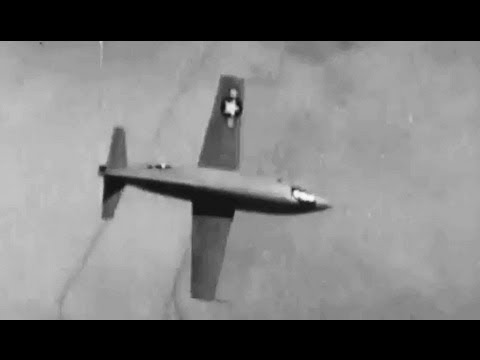more at
Silent but detailed documentary of Chuck Yeager making the first supersonic flight in the Bell X-1 “Glamorous Glennis” on October 14, 1947.
Public domain film from the US Air Force, slightly cropped to remove uneven edges, with the aspect ratio corrected, and mild video noise reduction applied.
The Bell X-1, originally designated XS-1, was a joint NACA-U.S. Army Air Forces-U.S. Air Force supersonic research project built by the Bell Aircraft Company. Conceived in 1944 and designed and built during 1945, it reached nearly 1,000 m.p.h. (1,600 km/h) in 1948. A derivative of this same design, the Bell X-1A, having greater fuel capacity and hence longer rocket burning time, exceeded 1,600 m.p.h. (2,575 km/h) in 1954. The X-1 was the first airplane to exceed the speed of sound in level flight and was the first of the so-called X-planes, an American series of experimental rocket planes designated for testing of new technologies and often kept secret…
On 16 March 1945, the U.S. Army Air Forces Flight Test Division and the National Advisory Committee for Aeronautics (NACA) made a contract with the Bell Aircraft Company to build three XS-1 (for “Experimental, Supersonic”, later X-1) aircraft to obtain flight data on conditions in the transonic speed range.
The X-1 was in principle a “bullet with wings”, its shape closely resembling a Browning .50-caliber (12.7 mm) machine gun bullet, known to be stable in supersonic flight. The pattern shape was followed to the point of seating its pilot behind a sloped, framed window inside a confined cockpit in the nose, with no ejection seat. After the rocket plane ran into compressibility problems in 1947, it was modified with variable-incidence tailplane. An all-moving tail was developed by the British for the Miles M.52, but was first used in transonic flight on the X-1, allowing it to pass through the sound barrier safely.
The rocket propulsion system was a four-chamber engine built by Reaction Motors, Inc., one of the first companies to build liquid-propellant rocket engines in America. This rocket burned ethyl alcohol diluted with water with a liquid oxygen oxidizer. Its thrust could be changed in 1,500 lbf (6,700 N) increments by firing just one or more than one of its chambers. The fuel and oxygen tanks for the first two X-1 engines were pressurized with nitrogen gas, but the rest used steam-driven turbopumps. The all-important fuel turbopumps, necessary to raise the chamber pressure and thrust while making the engine lighter, were built by Robert Goddard, who was under a contract with the U.S. Navy to provide jet-assisted takeoff (JATO) rockets…
On 14 October 1947, just under a month after the U.S. Air Force had been created as a separate service, the tests reached their peak with the first manned supersonic flight, piloted by Air Force Captain Charles “Chuck” Yeager in aircraft #46-062 that he had christened the Glamorous Glennis for his wife. This rocket-powered airplane was launched from the bomb bay of a modified B-29 Superfortress bomber, and it glided to a landing on the dry lake bed. XS-1 flight number 50 is the first one in which the X-1 recorded supersonic flight, at Mach 1.06 (313 m/s, 1,126 km/h, 800 mph) peak speed.
As a result of the X-1’s initial supersonic flight, the National Aeronautics Association voted its 1948 Collier Trophy to be shared by the three main participants in the program. Honored at the White House by President Harry S. Truman were Larry Bell for Bell Aircraft, Captain Yeager for piloting the flights, and John Stack for the contributions of the NACA.
The story of Yeager’s 14 October flight was leaked to a reporter from Aviation Week, and The Los Angeles Times featured the story as headline news in their 22 December issue. The magazine story was released 20 December. The Air Force threatened legal action against the journalists who revealed the story, but none was ever taken.
On 5 January 1949, Yeager used Aircraft #46-062 to carry out the only conventional (runway) take off performed during the X-1 program, reaching 23,000 ft (7,000 m) in 90 seconds…

